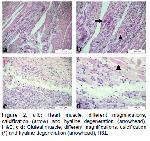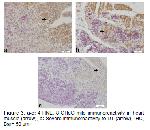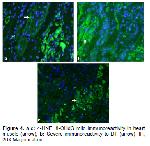WMD is seen as congenital form in newborns or adoptive form in 3-4 months old lambs and the clinical course of the disease varies as peracute, acute and subacute forms
1,6. The main clinical findings of the disease are as follows; inability to stand up, stiff-legged gait, shortness of breath, loss of appetite, weakness, unwillingness to move, difficulty in standing, stiff gait, curvature of the back, short and upright steps
4,8. In our study, in accordance with the literature data
1,6, the disease was detected mostly in animals up to 3 months (18 out of 20 animals, 90%). The remaining 2 animals were 1 week - 10 days old. In addition, many clinical symptoms such as anorexia, inability to get up from the ground, reluctance to move, hunched back, stiff gait, curvature of the back, short and upright steps, shortness of breath, inability to lift the head and limpness were noted in animals, as previously reported
4,8,28,29. In the present study, the diagnosis of WMD in lambs was made based on observed macroscopic and microscopic lesions (6, 28). The gross
2,7,13 and histopathological lesions
29-31 in the heart and gluteal muscles we detected in lambs were similar to those previously reported by different researchers.
The most important factors in the etiology of WMD in lambs are Vit E and / or Se deficiency 5,7. Se enters the structure of the enzyme of glutathione peroxidase (GSH-Px) which works in the body's antioxidant protection and reduces hydrogen peroxide, super-oxide radicals and lipid peroxides to water 4,8. Vit E is a lipophilic antioxidant that reduces hydroperoxide formation and acts to scavenge free radicals at the extracellular or intracellular level 9,14. Vit E and Se-containing GSH-Px, are an important part of the antioxidant system found in all cells. In WMD, lipid peroxidation and hydrogen peroxide normally occurring in the organism cannot be scavenged from the muscles due to the decrease in GSH-Px activity caused by Se and antioxidant Vitamin E deficiencies 11. Free oxygen radicals that develop due to the decrease in antioxidant activity play a serious role in the pathogenesis of the disease by causing severe pathological changes such as lipid peroxidation in tissues, degradation of proteins, degeneration and finally necrosis of the myocardium 3,13. Therefore, an increase in oxidative stress and 4-HNE expression, which is an important active lipid peroxidation marker in heart tissue, is thought to be due to the decrease in antioxidant defense 17. As we expected, we found that 4-HNE expression increased statistically in the WMD group compared to the control group. In human medicine, there are findings that 4-HNE is produced in the heart in cardiovascular diseases such as atherosclerosis, hypertrophy, cardiomyopathy, myocardial ischemia-reperfusion injury and arrhythmias compared to healthy individuals in the control group of 4-HNE 32,33. In the literature review, no study was found in which lipid peroxidation in lambs with WMD was evaluated in terms of 4-HNE expressions by immunohistochemical methods. Consistent with our results, different researchers found that lipid peroxidation increased in WMD animals compared to healthy animals in terms of Malondialdehyde (MDA) levels 1,5,14. DT is a prominent marker for oxidative stress as protein oxidation and is formed by ROS attack on a wide range of proteins 20,22,23. DT is an irreversible and irreparable oxidative modification 21. We did not find any literature data in which DT expressions were evaluated by immunohistochemical methods in white muscle disease. However, it has been reported that DT levels increase statistically in disease group compared to the control group for chronic heart failure and acute myocardial infarction models 22,23,33. In the present study, we observed that DT expression in the heart of the animals in the WMD group was quite severe and increased significantly compared to the control group. We interpreted this increase in DT immunoreactivity as ROS-induced protein modifications may play an important role in the pathogenesis of WMD. ROS can cause specific oxidative DNA damage and 8-OHdG is the most used biomarker to detect this damage 1,24. 8-OHdG values have been evaluated in detail in human cardiovascular diseases such as coronary artery disease, non coronary artery disease, myocardial infarction, ischemic stroke, heart failure, atherosclerosis 25,26. In the literature reviews, it is seen that there is a positive relationship between 8-OHdG levels and cardiovascular diseases 25,26. However, there is only one study in which 8-OHdG levels were evaluated in immunohistochemical methods in lambs with WMD 1. We determined that the 8-OHdG expressions in the heart tissue of lambs with WMD increased statistically compared to control animals similar to that reported by Yildirim et al., 2019 1. We believe this increase in 8-OHdG immunoreactivity in lambs with WMD is likely a result of ROS-induced DNA damage. We think that ROS-induced lipid peroxidation and protein modifications as well as DNA damage play an important role in the pathogenesis of WMD.
In conclusion, this study revealed that ROS, which is an important factor in the pathogenesis of WMD, causes lipid peroxidation, protein modification and DNA damage. There is no literature data in which important oxidative stress markers such as 4-HNE, DT and 8-OHDG were evaluated together with IHC and IF methods in lambs with WMD. In this respect, we believe that the data obtained from this study will contribute to the pathogenesis of the disease and the literature data.







